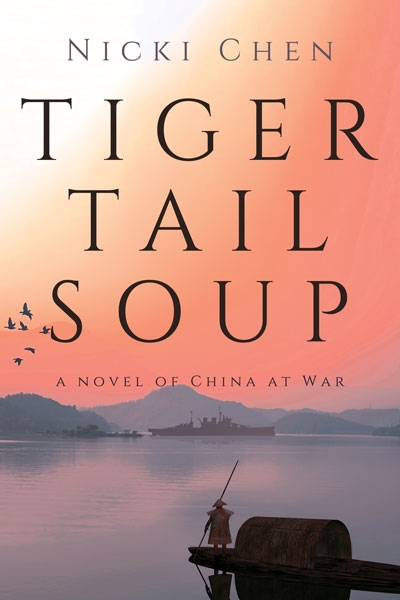Thinking in reverse.
Years ago, when I did Chinese brush painting, the process was straight forward. I applied ink and color directly to rice paper. Anything I didn’t touch just stayed white.
Then I took up batik painting, and I had to start thinking in reverse. Batik is a resist process in which anything the artist paints, stays the same. Everything else changes color in a dye bath.
There must be a variety of ways to do batik, but I’ll briefly explain my process.
The basic process for making batik.
First, I did a pencil drawing of the design I wanted on a piece of white cotton or silk. Then I stretched the fabric over a wooden frame and attached it with thumb tacks. I melted a mixture of paraffin and beeswax in a pot, and when the wax was hot enough, I painted it onto the fabric with a brush or tjanting.
Anything I painted with wax remained white when I bathed the cloth in the first dye bath. After the fabric dried, I could wax and save that first color and dye what remained another color. Then I could apply more wax and dye it again with a third color. Choosing appropriate colors, the process could be repeated several times.
Finally, I boiled the fabric or ironed it between sheets of paper to remove all the wax.

To achieve a crackled look, the white breaking wave was waxed with a high percentage of paraffin wax.– batik on cotton by Nicki Chen (with a tip of the hat to Hokusai, the famous Japanese printmaker.)
Before melting the wax, I had to determine what kind of mixture of waxes I wanted. If I wanted more of the crackle or veins characteristic of batik, I would increase the percentage of paraffin wax. For a smoother effect, I would use more beeswax. The beeswax would bend but not break when I wrinkled or squeezed the cloth. The paraffin wax would crack and thus allow a little dye to enter into the cracks.
The traditional method of applying wax is with the tjanting, a simple tool composed of a small copper cup attached to a wooden handle. The artist fills the cup with hot wax and drips wax through a spout onto the cloth to make the design.
I did use the tjanting in some of my paintings, but I never became an expert. Whether using a tjanting or a brush, the artist has to get the heat and speed just right. If the wax isn’t hot enough, it won’t fully penetrate the fabric. If it’s too hot or the artist’s hand is too slow, the wax spreads and the line becomes a blob. I primarily used brushes to achieve the effect I wanted.
Choosing colors for batiks.
In its most basic form, the batik artist uses colors from one side of the color wheel and moves from lighter, primary colors to darker secondary or mixed colors. For example, after “saving” the white fabric with wax, I might choose yellow for my first dye. After waxing the yellow portions I wanted to save, I might dye the cloth light blue to make yellow green, and then dark blue for the final dye to make dark green.
More complex color combinations could be achieved through advanced techniques. In every case, the artist paints the portion of the cloth she wants to remain untouched by the dye, thus saving what already exists.
A British teacher; an outdoor classroom.
 My batik teacher, John Heap, was a tall thin Brit who wore sandals and did yoga before yoga was popular in the West. He studied batik in Indonesia. Then he moved to the Philippines, rented a small house with a spacious patio and carport, and advertised for students. We were glad to work outside so the fumes from the molten wax had someplace to go.
My batik teacher, John Heap, was a tall thin Brit who wore sandals and did yoga before yoga was popular in the West. He studied batik in Indonesia. Then he moved to the Philippines, rented a small house with a spacious patio and carport, and advertised for students. We were glad to work outside so the fumes from the molten wax had someplace to go.
 My mom took a few classes while she was visiting. She made a tablecloth with a geometric design and a wall hanging depicting a carabao (water buffalo).
My mom took a few classes while she was visiting. She made a tablecloth with a geometric design and a wall hanging depicting a carabao (water buffalo).
Dozens of batik wall hangings and a four-panel screen.
I made dozens of batik wall hangings. Some I sold; others I gave away or stored in trunks. A few are now hanging on my walls.
I did have a four-panel batik screen made from a sketch I did in the mountains of Baguio. Now I have a three-panel screen. I’m not complaining. The screen had many years of use before the visiting cat galloped across the dining table, slid on the tablecloth, leap into the first panel of the screen with his claws out, and found that the silk was not as solid as he’d hoped.
He was an exuberant teenage cat. What did I expect?













You learned well from John Nicki. I wonder if you can remember me?
Chita. Hi. Yes. How are you? I stopped doing batik after we moved back to the US. It works better in a warm climate where you can work in the carport.
Wow!!! Nicki, I LOVE your batiks!!! I took a one day class that taught several different techniques for dying fabric, but none on painting it. I also did a simple batik project with my children back in the 70s using permanent markers and paraffin. I wondered if I could have just used white crayon in place of the paraffin?
Thank you, Barb. These pieces were all done by dyeing the fabric. What I painted was the wax. I suppose you could use anything that’s waxy to resist the dye as long as you heat it enough so that it soaks into the cloth.
Absolutely stunning! I had no idea batik could be so finely detailedーand colorful! Your works are amazing! How long does the process take? For example, you mention the horse was done with one waxingーI assume the more waxing, the longer the process? (I actually have many more questions I realized, but maybe I’ll google the basics.) Thank you for sharing your wonderful works of art! ^^
You’re right, it is a long process, especially when more colors are involved. I started with a sketch. Then I enlarged the sketch and copied it onto the cloth. Next steps: wax, dye, hang the fabric up to dry, and then start all over for the next color. At the end, remove the wax by boiling the waxed cloth, or iron it off with multiple pieces of paper or newspaper. I worked on more than one piece at a time, and since I lived in the Philippines, I had household help to help me with the final step. I never counted how many hours I spent, but it was a lot.
Wow, you are an artist! Your batiks look awesome!
Thanks, Marta. My mom and grandma got me interested in art at an early age. I worked at it most seriously when I was an “expat wife” in the Philippines. Then I started writing and left art behind. I still enjoy visiting art galleries though.
Totally Awesome, your batik is so Beautiful!!! Thanks for sharing…
Thank you, Julie. I’m glad you enjoyed it.
Wow! Nicki, you keep surprising me with your arts! 😀
Thank you, Hari. I had time on my hands when we were in the Philippines, and this was a fun new art form to learn.
I am completely blown away by the beauty of these batiks. I had no idea what goes into producing one and feel fairly certain I would make a mess of it. And you’re not kidding, that John Heap is one tall drink of water. I enjoyed seeing your mother looking so very pleased with her work.
My mother passed away a couple of years ago, so it was fun for me to find these pictures of her. She was an amateur artist who ignited my interest in art early. She was also a skilled seamstress.
These are exquisite, Nicki! The kids holding hands, the dolphins, the musician, the young girl with the cat, the wave & mountain, the heron ~ all AWESOME.
Thanks so much for sharing them with us.
Nancy, it’s fun to be able to share them since some of these batiks have been hiding in a trunk.
These are all such beautiful pieces, Nicki. It appears to be a process that requires a lot of patience…something I don’t always have. Thanks for sharing this with us.
Each painting did take a lot of time and work, but it was always fun to see how it turned out.
Wow! You’re a very talented artist!!! Ever thought about writing and illustrating a children’s picture book in batik? I assure you it’s never been done. It could be a show-stopper! Think about it! xxoo
I did think about illustrating a children’s book once. But that was a long, long time ago, and I had no idea how to go about it. I can see that batik could be an interesting medium for illustrating a children’s book. Unfortunately, I haven’t worked with it for quite a few years.
You are very talented. I took a class in Chinese painting and had a tough time mastering how to hold the brush. These are very intricate and beautiful.
Thank you, Kate.
An added benefit of holding your brush the Chinese way is that it forces you to sit up straight rather than leaning toward the hand you’re using. I’ve noticed that most Asians hold their pens and pencils the same way.